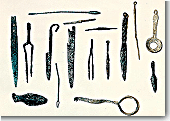





     |
|
|
|
Prophets and healers are mentioned by Homer as the first itinerant professionals. The word used to describe the mobility of both was epidemia. No clear distinction was made between the two, and most of the mythological prophets, as well as those who were active in historical times, were regarded as endowed with unusual magical and therapeutic powers. There were many myths connected with their life and work, such as the prolonged slumbers of Melampus and Epimenides. Their life and travels contain a specially existentialist dimension. Frequently they have committed some excess; have been harshly punished; and have been compensated by the gods with the gift of prophecy. This was so in the case of Tiresias, blinded by Hera; and Cassandra, who denied Apollo (Aeschylus, Agamemnon 1198-1212). Calchas and Helenus had denied their homeland and given their services to its enemies.
|
 |
The descendants of Podalirius settled at Cos and practised healing, always transmitting their skills from generation to generation. The most celebrated member of this family, who were called the Asclepiadae, was Hippocrates. The healing families continued to specialize in the traditions of the |
Healing skills had already started to be systematized even before Hippocrates. One of the most important doctors at the end of the Archaic period was Democides of Croton. Taken prisoner by Darius as a member of the court of Polycrates of Samos, he managed to get himself appointed personal doctor to the queen Atossa. After winning her trust by spectacular therapies, he was freed with her help. It was at the same period that the healer Alcmaeon was active: he too came from Croton. |
|
| |
|
Note: Click on a picture for a brief description. | |